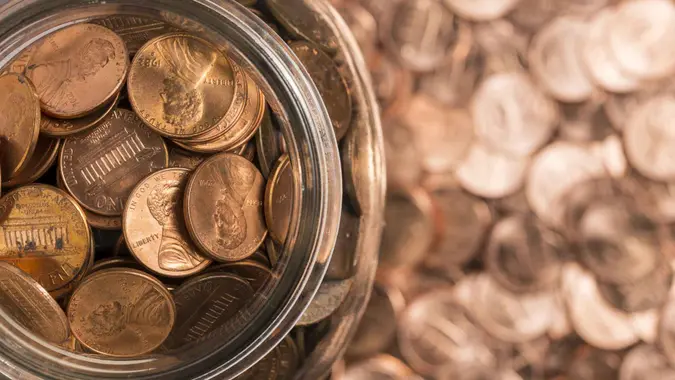Dave Ramsey: 6 Factors That Explain Why Gas Prices Are So High

Commitment to Our Readers
GOBankingRates' editorial team is committed to bringing you unbiased reviews and information. We use data-driven methodologies to evaluate financial products and services - our reviews and ratings are not influenced by advertisers. You can read more about our editorial guidelines and our products and services review methodology.

20 Years
Helping You Live Richer

Reviewed
by Experts

Trusted by
Millions of Readers
If you’ve filled up your gas tank lately, you’ve likely felt a bit of a sting as it seems prices have gotten out of control again — especially in some parts of the country. Owners of larger cars in some states now regularly pay over $100 to fill up, and this can really take a bite out of your monthly budget.
But what exactly makes gas prices so expensive, and what factors may actually drive prices down in the future? Noted financial personality Dave Ramsey answered a lot of these questions in a recent article on his Ramsey Solutions website. Highlights are listed below.
Geopolitical Tension
Any time there is uncertainty in the world — particularly around oil-rich regions like the Middle East — oil and gas prices tend to rise. In late 2023, there are two global conflicts that are creating heightened anxiety around both the security of the world overall and also access to important oil-producing regions.
Specifically, the ongoing Russia-Ukraine war and the sudden conflict between Hamas and Israel has affected oil and gas deliveries and stoked fears of wider global conflicts. These are both huge contributors to the price of gas at your local pump.
Inflation
Even when there is peace across the oil-producing world, inflation can drive gas prices higher. In 2022 and 2023, inflation in the United States hit the highest levels in 40 years, and this has driven up the prices of nearly anything you can buy, including gasoline. Fortunately, the Fed seems to be winning its war against inflation, as rates have been nearly cut in half since their summer 2023 peak.
Seasonality
Gasoline prices are also affected throughout the year by seasonality. In summer, for example, Americans tend to go on vacation, and this almost invariably means more cars are on the road. As Americans go on road trips, drive to visit friends or even catch a ride to the airport, more gas is being consumed, and this has an effect on prices.
In winter, on the other hand, while many Americans travel to ski resorts, driving demand is dampened for a number of reasons, from those who prefer to stay home for the holidays to those who simply don’t want to (or can’t) drive during poor weather.
Refinery Issues
Refineries are the last step in the gas supply chain before the product is distributed to customers. If there’s a problem with production or delivery, that creates a shortage in the gas supply chain, which can drive up prices.
This is why if you hear about a fire or shutdown at a refinery, you’re likely to see a spike in gas prices, even if it’s only short-term in nature and/or just a knee jerk reaction.
Governmental Actions
Actions of federal and state governments can also play a role in the price of gas. In times of shortages, for example, the federal government may release barrels of oil from the Strategic Petroleum Reserve. This can help contain prices as it both increases the amount of oil available for use and acts as a symbolic move to help bring stability to the market.
In 2022, a number of states, including California, offered qualifying residents a gas rebate check, designed to help offset the burden of higher gas prices. While this didn’t affect the actual price of gasoline, it did reduce the net cost of gasoline to state residents.
Supply and Demand
At the end of the day, supply and demand is what really drives gas prices. All of these other factors act to increase or reduce both supply and demand, and when this balance gets out of whack, prices go higher (or lower).
For example, summer driving patterns drive up the demand for gas, while in winter that demand tends to fall once again. Shortages of oil created by geopolitical conflict reduce supply, meaning demand outweighs supply and driving prices higher. Shuttered refineries also act to reduce supply, creating similar shortages. If supply ever overwhelms demand, then prices will fall once again.
Ways To Save on Gas
While individual consumers can’t affect the market price of gasoline, there are steps you can take to reduce the amount that you’ll actually pay.
For example, you can use apps like GasBuddy to show you the prices of gas at different stations, allowing you to pick the most convenient station with the lowest price. Rewards programs at some gas stations may offer you 10 cents off the cost of each gallon of gas if you simply sign up. Certain credit cards will pay you back a percentage of the amount you spend on gas, typically in the form of cash back.
Beyond these more modern methods, you can use traditional ways to save on gas, such as planning out your trips to minimize your driving and carpooling when available. If you live close to a state line, you may be able to take advantage of much lower gas prices simply by driving a few blocks down the street, as gas taxes can vary dramatically from state to state.
 Written by
Written by  Edited by
Edited by 

























